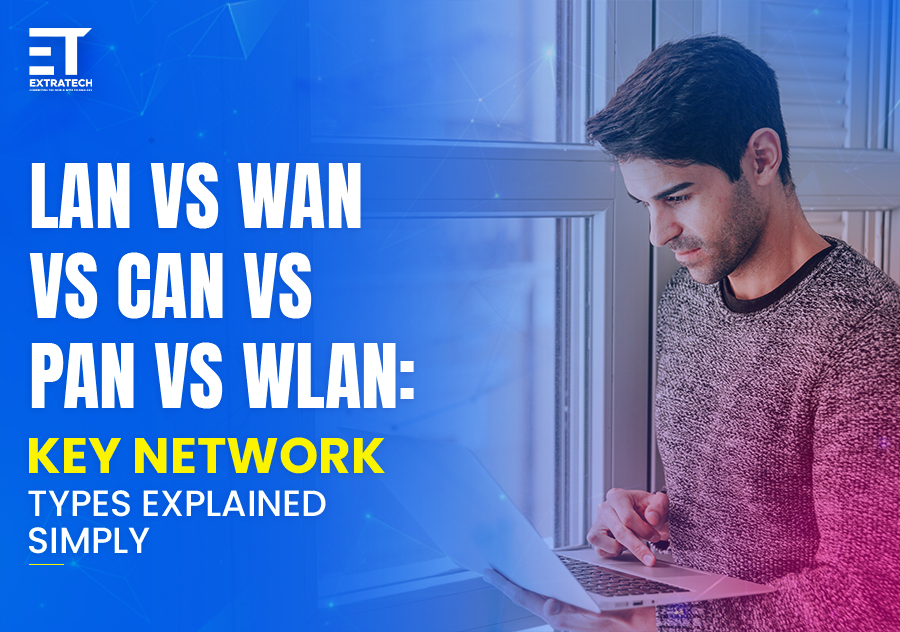LAN vs WAN vs CAN vs PAN vs WLAN: Key Network Types Explained Simply
Whether you work in IT, study technology, or simply want to understand how devices communicate, learning about LAN, WAN, CAN, PAN, and WLAN will help. Each network type serves a unique role.
A Local Area Network (LAN) stands as one of the most familiar network types. It links devices within a small area such as a home, office, or building. Commonly, computers, printers, and servers connect through Ethernet cables or Wi-Fi. This configuration allows fast speeds and low latency, which enhance file sharing and resource access.
Additionally, LANs tend to be privately owned, giving organizations full control over their setup and upkeep. Wired connections are typical, though wireless alternatives like WLANs are growing in popularity. Since LANs cover limited areas, troubleshooting and upgrades tend to be easier and less costly than larger networks.
In summary, LANs suit environments needing reliable, high-speed connections across short distances.
WAN: Wide Area Network Explained
Unlike LANs, Wide Area Networks (WANs) cover vast geographic areas, connecting multiple LANs across cities, countries, or even continents. The internet itself serves as the largest WAN example.
WANs utilize various technologies, including leased lines, satellites, or public internet to cover these distances. Because data travels farther, WAN speeds usually lag behind LAN speeds, and latency increases correspondingly. Managing a WAN is more complex since it often spans multiple service providers and diverse hardware.
Importantly, WANs permit remote offices or organizational branches to communicate, enabling global teamwork. Despite their complexity, WANs remain crucial for linking the world digitally.
CAN: Campus Area Network Explained
The Campus Area Network (CAN) lies between LAN and WAN regarding size. It connects several LANs within a limited geographic area like a university campus, corporate office park, or hospital complex. CANs maintain high-speed connections while expanding coverage across multiple buildings.
One advantage of CANs is centralized network management combined with strong speed and reliability. Typically, fiber optics or high-speed Ethernet links interconnect buildings. Given sensitive data is often involved in such environments, security protocols are typically stringent.
Overall, CANs facilitate efficient resource sharing and communication within institutional campuses, helping streamline operations.
PAN: Personal Area Network Explained
Personal Area Networks (PANs) operate at the smallest scale. These networks connect devices within a few meters of an individual. Examples include smartphones, tablets, smartwatches, or wireless headphones connected via Bluetooth or USB.
PANs focus on device-to-device communication for personal convenience. For example, syncing a smartwatch with a smartphone or connecting a laptop to a portable printer. Because of the limited range, PANs prioritize ease of use and simplicity rather than broad coverage.
With the rise of wearable technology and smart devices, PANs are growing increasingly common. They enhance personal productivity by allowing seamless interaction between gadgets.
WLAN: Wireless Local Area Network Explained
Wireless Local Area Networks (WLANs) extend the LAN concept by incorporating wireless access. Devices connect via Wi-Fi within limited areas such as offices, homes, or cafés, removing reliance on physical cables.
This wireless flexibility greatly appeals to users, enabling mobility and improving productivity. WLANs generally consist of access points linked to a wired LAN backbone, dispersing Wi-Fi signals throughout the coverage area.
Nevertheless, WLANs face higher security challenges than wired LANs. Therefore, encryption protocols like WPA3 and constant monitoring are necessary to prevent unauthorized access.
Thus, WLANs offer the convenience of wireless connectivity while retaining many benefits of traditional LANs.

